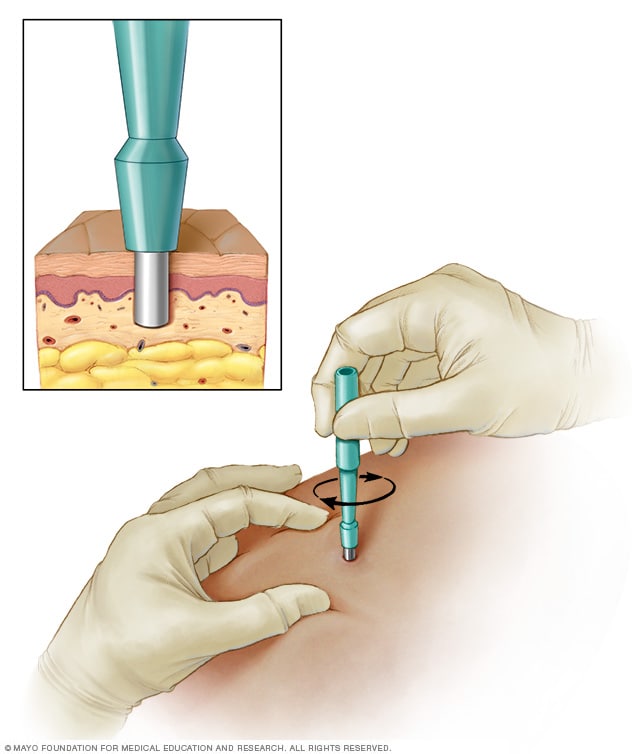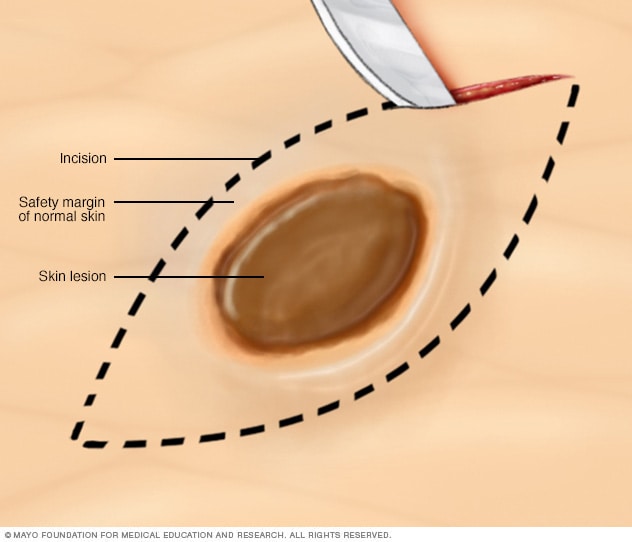Diagnosis
Punch biopsy

Punch biopsy
During a punch biopsy, a round-tipped cutting tool is used to remove deeper layers of skin for testing. Depending on the size, stitches may be needed to close the wound.
Excisional biopsy

Excisional biopsy
During an excisional biopsy, a scalpel is used to cut out a lump or an area of irregular skin and some surrounding healthy skin. As a rule, stitches are needed to close the wound.
Tests and procedures used to diagnose cutaneous T-cell lymphoma include:
- Physical exam. Your doctor will examine your skin for patchy, scaly regions or solid, raised growths. You will also be examined for signs that your lymph nodes or other organs might be affected.
- Blood tests. Blood tests such as the complete blood count might be used to better understand your condition. Sometimes cancer cells are found in the blood, particularly with Sezary syndrome.
-
Skin biopsies. A procedure to cut away a small sample of skin (skin biopsy) is usually needed to diagnose cutaneous T-cell lymphoma. The skin might be cut with a circular tool (punch biopsy). For larger lesions and tumors the biopsy might be done with a small knife (excisional biopsy).
A doctor who specializes in analyzing blood and tissue (pathologist) examines the sample in a lab to determine whether it contains cancer cells. Sometimes multiple skin biopsies are necessary to confirm your diagnosis. Advanced lab tests to analyze the tissue might uncover clues about your cancer that will help your doctor understand your prognosis and determine your treatment options.
- Imaging tests. If there's concern that the cancer cells have spread to other parts of the body, your doctor might recommend imaging tests, such as computerized tomography (CT) or positron emission tomography (PET) scans.
More Information
Treatment
Many treatments are available for people with cutaneous T-cell lymphoma. Which treatments are best for you depends on your particular situation, including the extent or stage of your lymphoma. Most people receive a combination of treatments for cutaneous T-cell lymphoma.
Treatment options may include:
- Skin creams and ointments. Medicines can be applied to your skin in the form of creams, gels and ointments. Corticosteroids can help control skin redness and itchiness. Chemotherapy can be applied to the skin to attack cancer cells.
- Light therapy (phototherapy). Phototherapy involves exposing the skin to wavelengths of light, such as ultraviolet B or ultraviolet A. Various machines are used in phototherapy, including booths that expose most of your body to the light. Sometimes phototherapy is done after the application of a medication that makes skin cells more sensitive to light (photodynamic therapy). Healthy cells regenerate quickly, but cancer cells do not.
- Radiation therapy. Radiation therapy uses beams of energy to kill cancer cells. If you have one area of cutaneous T-cell lymphoma, standard radiation therapy with X-rays might be recommended. For people with more areas of cancer, radiation therapy might be done with electron beams, which target the skin and don't affect internal organs. Electron beam radiation is usually applied to all of the skin.
- Medications. Medications used to treat cutaneous T-cell lymphoma include treatments to control the immune system, such as steroid drugs and interferon. Chemotherapy medicines attack quickly growing cells, including cancer cells. Targeted therapy medicines attack cancer cells by targeting the cells' specific vulnerabilities.
- Exposing blood cells to light. A procedure called extracorporeal photopheresis involves taking a medicine that makes your cells more sensitive to light. Then your blood is filtered through a machine that exposes it to ultraviolet light before returning the blood to your body.
- Bone marrow transplant. A bone marrow transplant, also known as a stem cell transplant, is a procedure to replace your diseased bone marrow with healthy bone marrow from a matched donor (allogeneic bone marrow transplant). During a transplant you'll receive chemotherapy drugs to suppress your diseased bone marrow. Then healthy donor cells are infused into your body where they travel to your bones and begin rebuilding your bone marrow.
Clinical trials
Explore Mayo Clinic studies testing new treatments, interventions and tests as a means to prevent, detect, treat or manage this condition.
Lifestyle and home remedies
Taking measures to care for your skin may help relieve symptoms, such as itching, and reduce your risk of infections. Your doctor may give you specific treatments to control itching and manage your infection risk.
It may also help to:
- Use mild, unscented soap. Using a mild soap that doesn't cause additional irritation may help control itchiness.
- Keep skin moisturized. Applying lotion to your skin after showers and baths can help control itchiness and create a barrier to protect against germs that can cause infections.
- Ask about bleach baths. Ask your doctor whether it may be helpful for you to take regular bleach baths or soaks to reduce your risk of infections. For a bleach bath, add 1/2 cup (118 milliliters) of household bleach, not concentrated bleach, to a 40-gallon (151-liter) bathtub filled with warm water. Measures are for a U.S.-standard-sized tub filled to the overflow drainage holes. Soak for up to 10 minutes two or three times a week. After, rinse with clean water and apply moisturizer.
Coping and support
With time, you'll find what helps you cope with the uncertainty and distress that comes with a cancer diagnosis. Until then, you may find it helps to:
- Learn enough about lymphoma to make decisions about your care. Ask your doctor about your cancer, including your test results, treatment options and, if you like, your prognosis. As you learn more about cancer, you may become more confident in making treatment decisions.
- Keep friends and family close. Keeping your close relationships strong will help you deal with your cancer. Friends and family can provide the practical support you'll need, such as helping take care of your home. And they can serve as emotional support when you feel overwhelmed by cancer.
-
Find someone to talk with. Find a good listener who is willing to listen to you talk about your hopes and fears. This may be a friend or family member. The concern and understanding of a counselor, medical social worker, clergy member or cancer support group also may be helpful.
Ask your doctor about support groups in your area. Other sources of information include the National Cancer Institute and the Leukemia & Lymphoma Society.
Preparing for your appointment
Start by making an appointment with your primary care doctor if you have any signs or symptoms that worry you.
Here's some information to help you get ready for your appointment.
What you can do
When you make the appointment, ask if there's anything you need to do in advance, such as not eating before having a specific test. Make a list of:
- Your symptoms, including any that seem unrelated to the reason for your appointment
- Key personal information, including major stresses, recent life changes and family medical history
- All medications, vitamins or other supplements you take, including the doses
- Questions to ask your doctor
Bring a family member or friend with you, if possible, to help you remember the information you're given.
For cutaneous T-cell lymphoma, some basic questions to ask your doctor include:
- What's likely causing my symptoms?
- Other than the most likely cause, what are other possible causes for my symptoms?
- What tests do I need?
- What's the best course of action?
- What are the alternatives to the primary approach you're suggesting?
- I have these other health conditions. How can I best manage them together?
- Are there restrictions I need to follow?
- Should I see a specialist?
- Are there brochures or other printed material I can have? What websites do you recommend?
Don't hesitate to ask other questions.
What to expect from your doctor
Your doctor is likely to ask you several questions, such as:
- When did your symptoms begin?
- Have your symptoms been continuous or occasional?
- How severe are your symptoms?
- What, if anything, seems to improve your symptoms?
- What, if anything, appears to worsen your symptoms?
Feb. 09, 2023